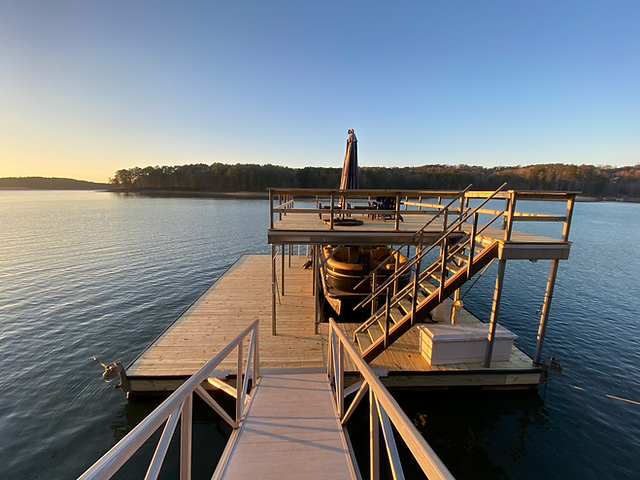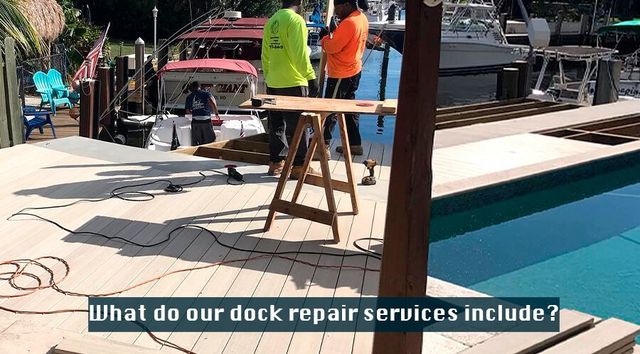How to Select the Right Solution for Your Dock Repairs
How to Select the Right Solution for Your Dock Repairs
Blog Article
Efficient Dock Repair Service Techniques: Making Sure Architectural Stability
Making certain the structural integrity of anchors through effective fixing methods is critical for the longevity and safety and security of marine centers. Subsequently, choosing the right repair service products, such as corrosion-resistant alloys and composite materials, is essential for longevity.
Evaluating Dock Damage
Examining dock damages is a vital first step in guaranteeing the architectural integrity and security of any kind of docking facility. Trick aspects to analyze include the dock's structure, pilings, decking, and equipment (Dock Repairs).
Architectural designers or certified inspectors usually execute these analyses making use of specialized methods and devices. Underwater evaluations might use sonar equipment or from another location ran cars (ROVs) to spot submerged damages. Above water, visual inspections are complemented by utilizing wetness meters and other diagnostic devices to discover underlying issues not instantly visible to the nude eye.

Choosing Repair Service Products
Picking the appropriate repair work materials is a critical action in the dock reconstruction process, one that directly influences the durability and efficiency of the fixed framework. Product option should be driven by aspects such as ecological problems, load-bearing requirements, and compatibility with existing dock elements. For example, wood is a standard selection for docks because of its all-natural resilience and aesthetic charm. However, selecting the right sort of wood, such as pressure-treated lumber or naturally rot-resistant types like cedar or teak, is important to stand up to marine settings.
In enhancement to wood, composite products are progressively prominent as a result of their toughness and reduced upkeep needs. Compounds, typically made from a mix of plastic and wood fibers, provide superb resistance to rot, insects, and UV damages. For metal docks, picking corrosion-resistant alloys such as galvanized steel or marine-grade aluminum is important to protect against corrosion and make certain architectural integrity in saline water problems.
Epoxy materials and marine-grade sealants are vital for repairing cracks and sealing joints, giving a waterproof barrier and improving the dock's total strength. By carefully choosing high-quality materials, dock repair work can attain durable results, thus securing versus future destruction and making certain safe, reputable usage.
Architectural Support Strategies
Reliable architectural support techniques are crucial in making sure the security and durability of dock repair services. One basic approach entails using steel or composite support bars (rebar) within concrete frameworks. Rebar supplies additional tensile toughness, protecting against splits and dispersing lots a lot more equally. This technique is especially efficient for docks exposed to heavy lots or rough ecological problems.
Another essential strategy is the application of fiber-reinforced polymers (FRP) These products provide high strength-to-weight ratios and superb resistance to deterioration, making them optimal for strengthening concrete or wood docks. FRP can be applied in sheets or strips and adhered with epoxy resins to enhance architectural stability.
Bracing and securing systems additionally play a crucial role in architectural support. Cross-bracing, making use of steel or wooden light beams, can neutralize side forces, reducing guiding and activity. Securing systems, such as helical piers or driven stacks, provide a stable structure by moving loads to much deeper, a lot more steady dirt layers.
Last but not least, the assimilation of load-distribution plates can aid disperse weight a lot more equally across the dock's surface, alleviating right here localized stress factors. These methods jointly make certain that docks remain durable and safe, capable of withstanding the rigors of their operational atmosphere.
Advanced Fixing Techniques

Another advanced technique involves underwater welding, which enables repairs to be conducted without the need to dewater the area. This approach is specifically useful for addressing architectural concerns in immersed dock elements, making sure very little disruption to operations. Boosted welding strategies, paired with robotic systems, deliver precision and integrity, therefore expanding the life expectancy of the dock.
Furthermore, cathodic security systems are executed to stop rust in metallic dock frameworks. By utilizing sacrificial anodes or pleased present systems, these techniques properly alleviate the electrochemical processes that result in material damage.
Finally, advanced monitoring modern technologies, such as architectural health monitoring (SHM) systems, provide real-time information on the problem of dock structures. These systems enable aggressive maintenance and timely treatments, eventually making certain the long-term architectural stability of the dock.
Upkeep and Prevention
Maintenance and prevention are basic ideas that underpin the longevity and security of dock structures. Routine inspections are vital, allowing for very early detection of deterioration, possible weaknesses, and ecological impacts. A positive approach, including regular checks for rust, rot, and architectural shifts, alleviates costly repair services and prolongs the dock's operational life.
Safety original site nets must consist of applying safety coverings to steel parts to defend against corrosion and using treated timber to resist decay. In addition, guaranteeing appropriate water drainage and air flow can avoid water build-up, which is an usual source of structural degradation. Integrating top quality products and adhering to producer guidelines throughout building and construction and repair phases likewise play vital duties in enhancing resilience.

Educating employees in dock upkeep ideal techniques makes sure constant application of safety nets. Leveraging technological advances, such as drones for inspections and sensing units for real-time surveillance, can better boost upkeep efforts. By prioritizing maintenance and avoidance, dock Full Report proprietors can guarantee structural honesty, functional security, and affordable management over the dock's lifespan.
Conclusion
In verdict, maintaining the structural stability of aquatic centers necessitates detailed dock fixing techniques. Advanced repair work methods, combined with normal upkeep practices, guarantee the dock stays functional and secure under varied ecological conditions.
Ensuring the structural stability of anchors via reliable repair techniques is critical for the durability and security of aquatic centers.Choosing the proper fixing products is a crucial action in the dock repair procedure, one that straight affects the durability and efficiency of the repaired structure.Effective structural reinforcement techniques are critical in ensuring the stability and long life of dock repairs. By focusing on upkeep and avoidance, dock owners can guarantee structural honesty, functional security, and economical management over the dock's lifespan.
In verdict, maintaining the architectural stability of marine centers demands detailed dock repair work techniques.
Report this page